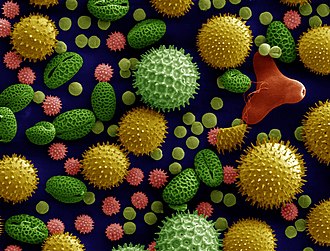Aeroplankton




Aeroplankton refers to the tiny life forms that are suspended in the air, similar to how plankton drift in water bodies. These microscopic organisms are primarily composed of bacteria, fungi, viruses, and small pollen particles. They play a significant role in the atmosphere, ecosystems, and even in the spread of diseases. Aeroplankton can be found in various environments, from urban areas to the most remote natural settings, highlighting their ubiquity and importance in global biogeochemical cycles.
Types of Aeroplankton[edit]
Aeroplankton is broadly categorized into two main types: biotic and abiotic components. The biotic components include living organisms such as:
- Bacteria - These are single-celled organisms that can be found in the air, especially in moist or humid conditions.
- Fungi - Spores of fungi are a common component of aeroplankton, capable of traveling long distances through the air.
- Viruses - Although not technically living organisms, viruses are often included in aeroplankton studies due to their capability to be airborne and impact living organisms.
- Pollen - Pollen grains from plants are also considered part of aeroplankton, playing a crucial role in plant reproduction and also in causing allergic reactions in humans.
The abiotic component mainly consists of non-living particles, such as dust and soot, which are not covered under the definition of aeroplankton but are often studied alongside due to their impact on air quality and living organisms.
Ecological Importance[edit]
Aeroplankton plays a critical role in various ecological processes. For instance, they are involved in the dispersal of fungi and bacteria that can be essential for nutrient cycling in different environments. Pollen, as part of aeroplankton, is crucial for the pollination of many plants, including several crops. Moreover, the study of aeroplankton can help in understanding the spread of airborne diseases and allergens, which is vital for public health and agriculture.
Challenges in Study[edit]
Studying aeroplankton poses several challenges due to their microscopic size and the vastness of the atmosphere. Techniques such as air sampling and molecular analysis are commonly used, but these methods require sophisticated equipment and expertise. Additionally, the composition of aeroplankton can vary significantly over time and space, making it difficult to obtain a comprehensive understanding of their dynamics and impacts.
Conclusion[edit]
Aeroplankton, though often overlooked, is an essential component of the Earth's atmosphere and ecosystems. Its study not only provides insights into air quality and climate change but also helps in understanding the spread of diseases and the ecological interactions between different life forms. As research techniques advance, our knowledge of aeroplankton and its impacts on the environment and human health is expected to deepen, highlighting the importance of these microscopic organisms in the global ecosystem.

Ad. Transform your life with W8MD's Budget GLP-1 injections from $75


W8MD offers a medical weight loss program to lose weight in Philadelphia. Our physician-supervised medical weight loss provides:
- Weight loss injections in NYC (generic and brand names):
- Zepbound / Mounjaro, Wegovy / Ozempic, Saxenda
- Most insurances accepted or discounted self-pay rates. We will obtain insurance prior authorizations if needed.
- Generic GLP1 weight loss injections from $75 for the starting dose.
- Also offer prescription weight loss medications including Phentermine, Qsymia, Diethylpropion, Contrave etc.
NYC weight loss doctor appointmentsNYC weight loss doctor appointments
Start your NYC weight loss journey today at our NYC medical weight loss and Philadelphia medical weight loss clinics.
- Call 718-946-5500 to lose weight in NYC or for medical weight loss in Philadelphia 215-676-2334.
- Tags:NYC medical weight loss, Philadelphia lose weight Zepbound NYC, Budget GLP1 weight loss injections, Wegovy Philadelphia, Wegovy NYC, Philadelphia medical weight loss, Brookly weight loss and Wegovy NYC
|
WikiMD's Wellness Encyclopedia |
| Let Food Be Thy Medicine Medicine Thy Food - Hippocrates |
Medical Disclaimer: WikiMD is not a substitute for professional medical advice. The information on WikiMD is provided as an information resource only, may be incorrect, outdated or misleading, and is not to be used or relied on for any diagnostic or treatment purposes. Please consult your health care provider before making any healthcare decisions or for guidance about a specific medical condition. WikiMD expressly disclaims responsibility, and shall have no liability, for any damages, loss, injury, or liability whatsoever suffered as a result of your reliance on the information contained in this site. By visiting this site you agree to the foregoing terms and conditions, which may from time to time be changed or supplemented by WikiMD. If you do not agree to the foregoing terms and conditions, you should not enter or use this site. See full disclaimer.
Credits:Most images are courtesy of Wikimedia commons, and templates, categories Wikipedia, licensed under CC BY SA or similar.
Translate this page: - East Asian
中文,
日本,
한국어,
South Asian
हिन्दी,
தமிழ்,
తెలుగు,
Urdu,
ಕನ್ನಡ,
Southeast Asian
Indonesian,
Vietnamese,
Thai,
မြန်မာဘာသာ,
বাংলা
European
español,
Deutsch,
français,
Greek,
português do Brasil,
polski,
română,
русский,
Nederlands,
norsk,
svenska,
suomi,
Italian
Middle Eastern & African
عربى,
Turkish,
Persian,
Hebrew,
Afrikaans,
isiZulu,
Kiswahili,
Other
Bulgarian,
Hungarian,
Czech,
Swedish,
മലയാളം,
मराठी,
ਪੰਜਾਬੀ,
ગુજરાતી,
Portuguese,
Ukrainian